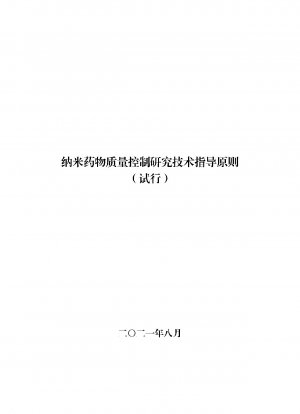Pharma-Guidelines-Nanodrug001
Technical guidelines for nanomedicine quality control research (Trial) (English Version)
- Standard No.
- Pharma-Guidelines-Nanodrug001
- Language
- Chinese, Available in English version
- Release Date
- 2021
- Published By
- National Health Commission of the People's Republic of China
- Scope
- Nanomedicine as mentioned in this guideline refers to nanoscale particles made from raw materials using nanopreparation technology, or nanoscale particles formed by combining raw materials with appropriate carrier materials, and their final products. Pharmaceutical preparations. The external dimensions, internal structure or surface structure of the final product or carrier material of a nanomedicine has a nanoscale (100nm and below), or the particle size of the final product or carrier material is usually below 1000nm, and has obvious scale effects. Nanomedicines generally have well-defined physical interfaces. Compared with ordinary drug preparations, nanomedicines have scale effects based on nanostructures and may have the following potential: (1) increase the solubility of drugs, improve the oral absorption of poorly soluble drugs, or significantly reduce food effects and inter-individual differences; (2) Improve the in vivo and in vitro stability of the drug by encapsulating or compounding the drug, or improve the dis olution or release behavior of the drug; (3) Improve the selectivity of the drug to tis ues, organs or cells, increase the drug efficacy and/or reduce the drug's Adverse reactions; (4) Realize new routes of adminis ration after making special preparations, optimize drug combination treatment strategies, or improve the druggability of candidate drugs; (5) Change the final preparation form, storage conditions or adminis ration methods of the drug, etc. Reduce storage and transportation costs, improve the convenience of drug production and use, or improve patient compliance, etc. Safety, effectiveness, and quality controllability are the basic principles followed in drug development and evaluation. The special nanosize, nanostructure and surface properties of nanomedicines may lead to significant changes in the drug's behavior in vivo and in vitro, thereby achieving clinical benefits. At the same time, the safety ris s brought by nanoscale effects may also increase accordingly. 1 Therefore, in-depth research and effective control of nanomedicine quality are very important to ensure the effectiveness and safety of nanomedicines. In view of the fact that the composition, structure, physical and chemical properties, preparation process, clinical preparation and use methods of nanomedicines may be quite different from traditional drugs, the quality control research of nanomedicines may need to follow general relevant technical guidelines. Redesign, optimize and validate applicable analytical and characterization methods for nanomedicines, and study the quality attributes related to nanomedicines. This guideline is drafted based on the relevant information of nanomedicines that have been marketed at home and abroad, relevant guiding principles, research reports of regulatory agencies or industry associations, scientific research literature, etc., and combined with the current status of nanomedicine research and development in China. It aims to provide guidance for the development of nanomedicines. Provide technical guidance for quality control studies. The drafting of this guideline is based on the current scientific understanding of nanomedicines. With the progress and experience accumulation of nanomedicine scientific research and technology, the relevant content will be continuously improved and updated in a timely manner.
